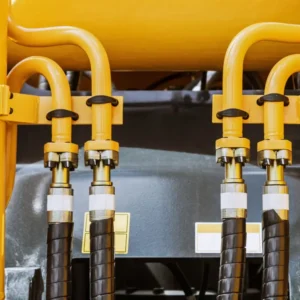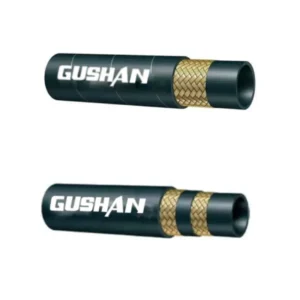Hydraulic hoses are an integral part of numerous industries, helping power heavy machinery, facilitate fluid transmission, and support essential operations. Without them, industries like construction, agriculture, and manufacturing would come to a halt.
This article provides a comprehensive guide on hydraulic hoses, their types, applications, maintenance, and much more.
What Is a Hydraulic Hose
A hydraulic hose is a flexible tube designed to convey high-pressure hydraulic fluid between components in a hydraulic system. These hoses are crucial in various industries, including construction, agriculture, manufacturing, and automotive, where they are used to transmit power and control machinery.
Hydraulic Hose Construction
A hydraulic hose is typically composed of three main layers:
Inner Tube:
- The innermost layer that directly contacts the hydraulic fluid.
- Made of rubber or synthetic materials like NBR (Nitrile Butadiene Rubber) or EPDM (Ethylene Propylene Diene Monomer).
- Resistant to the fluid’s pressure, temperature, and chemical properties.
Reinforcement Layer:
- Provides strength and prevents the hose from expanding or bursting under pressure.
- Can be made of:
- Wire Braid: Multiple layers of braided wire for high-pressure applications.
- Textile Braid: Flexible and lightweight, often used for lower-pressure applications.
- Spiral Wire: Offers good resistance to impulse pressure.
Outer Cover:
- Protects the inner layers from abrasion, weather, and other external factors.
- Made of rubber or synthetic materials, often the same as the inner tube material.
- Provides resistance to ozone, UV radiation, and chemicals.
SAE and EN Standards for Hydraulic Hoses
SAE (Society of Automotive Engineers) and EN (European Norm) are two major organizations that set standards for hydraulic hoses. These standards ensure quality, performance, and safety in hydraulic systems.
SAE Standards:
- SAE J517: This is a comprehensive standard covering various types of hydraulic hoses, including their construction, performance requirements, and testing methods. It categorizes hoses based on their pressure rating, temperature range, and fluid compatibility.
- SAE 100R Series: This series includes specific standards for different types of hydraulic hoses, such as:
- SAE 100R1: General-purpose hydraulic hose.
- SAE 100R2: High-pressure hydraulic hose.
- SAE 100R12: Wire braid reinforced hydraulic hose.
- SAE 100R13: Textile braid reinforced hydraulic hose.
EN Standards:
- EN 857: This standard covers the requirements for hydraulic hose assemblies, including dimensions, materials, performance, and testing methods.
- EN 853: This standard specifies the requirements for hydraulic hose fittings.
Key Considerations When Choosing a Hydraulic Hose:
When selecting a hydraulic hose, consider the following factors:
- Pressure Rating: Ensure the hose can handle the maximum system pressure.
- Temperature Range: Consider both operating and ambient temperatures.
- Fluid Compatibility: Choose a hose material compatible with the fluid.
- Flexibility: Select a hose with the required bending radius.
- Abrasion Resistance: Consider the exposure to abrasive environments.
- Standards Compliance: Ensure the hose complies with relevant SAE or EN standards.
By adhering to these standards and carefully selecting the appropriate hydraulic hose, you can ensure the safety, reliability, and efficiency of your hydraulic system.
What Are Hydraulic Hoses Made Of
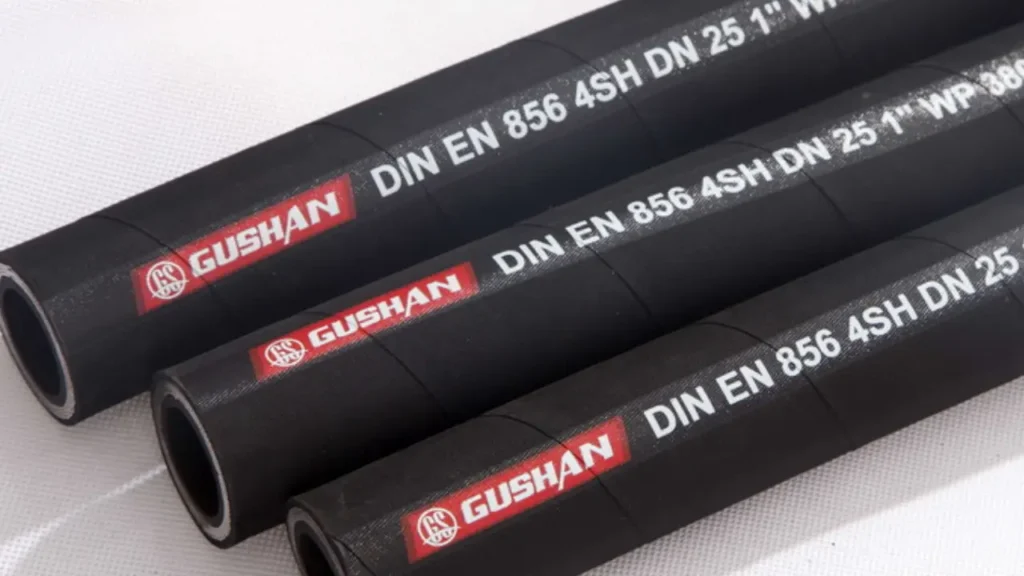
Hydraulic hoses are typically made of three main components:
- Tube: The inner layer that directly contacts the hydraulic fluid. It’s usually made of synthetic rubber like nitrile rubber (NBR) or ethylene propylene diene monomer (EPDM). These materials are resistant to the fluid’s pressure and chemical properties.
- Reinforcement: A layer of wire braid or textile fibers that provides strength and prevents the hose from expanding or bursting under high pressure.
- Cover: The outer layer that protects the reinforcement and tube from abrasion, weather, and other external factors. It’s often made of synthetic rubber like EPDM or chloroprene rubber (neoprene).
The specific materials used can vary depending on the application and the type of hydraulic fluid being used. For example, hoses used in high-pressure applications may have multiple layers of wire braid reinforcement, while hoses used in low-pressure applications may only have a single layer of textile braid.
What Are Hydraulic Hoses Used For
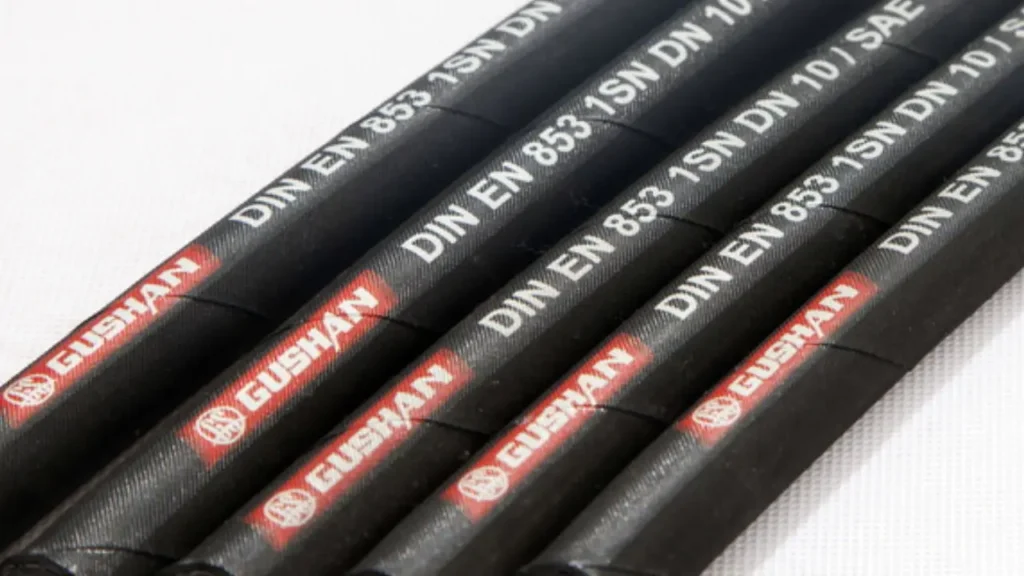
Who Uses Hydraulic Hoses?
Hydraulic hoses are used to transmit high-pressure hydraulic fluid between components in a hydraulic system.
Here are various hydraulic hose applications that you can get in the following:
Construction Equipment:
- Cranes
- Excavators
- Bulldozers
- Backhoes
- Forklifts
Agricultural Machinery:
- Tractors
- Harvesters
- Combine harvesters
- Sprayers
Industrial Machinery:
- Presses
- Injection molding machines
- Machine tools
- Material handling equipment
Automotive:
- Power steering systems
- Brake systems
- Suspension systems
Aerospace:
- Aircraft landing gear
- Flight control systems
Marine:
- Ship steering systems
- Winches
- Cranes
In these applications, hydraulic hoses are used to transmit power and control the movement of various components, such as cylinders, motors, and valves. They are crucial for the efficient and reliable operation of these machines and equipment.
What Are the 4 Types of Hydraulic Hoses
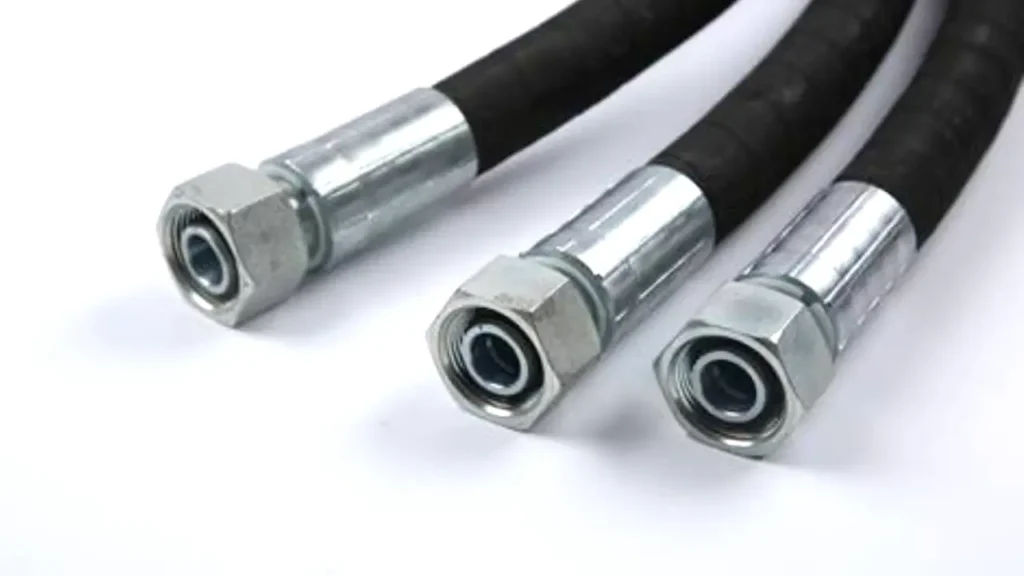
While there are many types of hydraulic hoses available, here are four common types:
- Rubber Hoses: These are the most common type of hydraulic hose, offering flexibility and resistance to a wide range of fluids. They are suitable for lower-pressure applications and are often used in mobile equipment.
- Wire Braid Hoses: These hoses are reinforced with multiple layers of braided wire, making them highly durable and resistant to high pressure and temperature. They are commonly used in heavy-duty applications such as construction and mining equipment.
- Textile Hoses: These hoses are reinforced with textile fibers, making them lightweight and flexible. They are often used in applications where weight and space are limited, such as agricultural equipment.
- Thermoplastic Hoses: These hoses are made from synthetic materials that offer excellent resistance to chemicals, heat, and abrasion. They are often used in high-pressure applications and are becoming increasingly popular due to their durability and flexibility.
It’s important to choose the right type of hydraulic hose for your specific application, considering factors such as pressure, temperature, fluid compatibility, and flexibility.
How Do I Choose the Right Kind of Hydraulic Hose
When selecting a hydraulic hose, several critical factors must be considered to ensure optimal performance and safety:
1. Pressure Rating:
- Ensure the hose can handle the maximum pressure of your hydraulic system.
- Consider both working pressure and potential pressure spikes.
2. Temperature Range:
- Select a hose that can withstand both the minimum and maximum operating temperatures.
- Consider ambient temperature and fluid temperature.
3. Fluid Compatibility:
- Choose a hose material compatible with the hydraulic fluid being used.
- Incompatible fluids can degrade the hose material.
4. Flexibility:
- Consider the required bending radius and movement of the hose.
- Flexible hoses are ideal for applications with frequent movement.
5. Abrasion Resistance:
- If the hose is exposed to abrasive environments, choose a hose with a durable cover.
6. Additional Factors:
- Vibration Resistance: For applications with high vibration, choose a vibration-resistant hose.
- Chemical Resistance: If the hose is exposed to chemicals, select a chemically resistant hose.
- UV Resistance: For outdoor applications, choose a UV-resistant hose.
Consulting Our Hydraulic Hose Specialist:
- For complex applications, consult with a hydraulic hose specialist.
- They can help you select the right hose and fittings for your specific needs.
By carefully considering these factors, you can choose the right hydraulic hose to ensure the reliable and efficient operation of your hydraulic system.
Ways to Lengthen Hydraulic Hose Lifespan
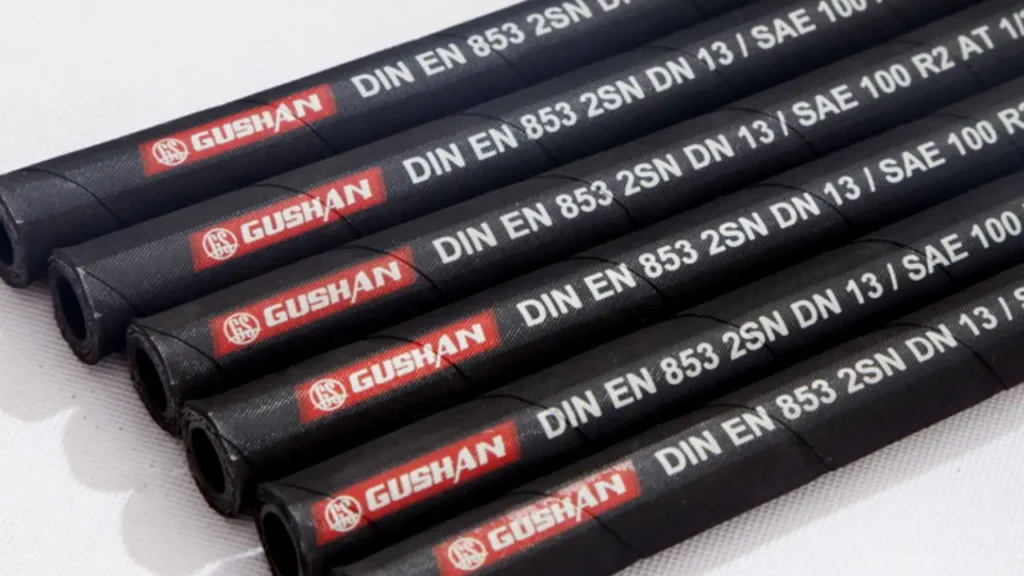
Hydraulic hoses are essential components in many industries, but they can be prone to wear and tear, especially in demanding environments. Here are some tips to extend the lifespan of your hydraulic hoses:
1. Regular Inspection:
- Visual Inspection: Regularly check for signs of wear, such as cuts, cracks, abrasions, or fluid leaks.
- Pressure Testing: Periodically test hoses for pressure leaks to identify potential issues early on.
2. Proper Installation:
- Avoid Kinking: Ensure hoses are routed properly to prevent kinking, which can weaken the hose and lead to failure.
- Correct Fittings: Use the correct fittings and tighten them to the manufacturer‘s specifications to avoid leaks.
- Proper Routing: Route hoses away from heat sources, sharp edges, and excessive vibration.
3. Optimal Operating Conditions:
- Pressure and Temperature: Operate hoses within their rated pressure and temperature ranges to avoid premature aging.
- Fluid Compatibility: Ensure the fluid used is compatible with the hose material to prevent degradation.
4. Protection from External Factors:
- Abrasion Guards: Use protective guards or sleeves to shield hoses from abrasion and physical damage.
- Weather Protection: Protect hoses from exposure to extreme weather conditions, such as UV radiation and moisture.
5. Proper Storage:
- Clean and Dry: Store hoses in a clean, dry environment, away from direct sunlight and heat sources.
- Avoid Sharp Bends: Avoid coiling hoses tightly, as this can damage the internal structure.
6. Timely Replacement:
- Replace Worn Hoses: Replace any hose showing signs of significant wear or damage to prevent unexpected failures.
By following these guidelines, you can significantly extend the lifespan of your hydraulic hoses, reduce downtime, and improve overall system reliability.
Would you like to learn more about specific types of hydraulic hoses or their applications?
Hydraulic Hose Assemblies
A hydraulic hose assembly is a complete unit consisting of a flexible hose and fittings attached to its ends. These assemblies are crucial components in hydraulic systems, transmitting high-pressure fluid to power various machinery and equipment.
Key Components of a Hydraulic Hose Assembly:
- Hydraulic Hose:
- The flexible tube that carries the hydraulic fluid.
- Made of various materials, such as rubber or synthetic polymers, to withstand pressure, temperature, and fluid compatibility.
- Fittings:
- Connect the hose to other components in the hydraulic system.
- Types of fittings include:
- JIC fittings: Common in mobile equipment.
- NPT fittings: Used in industrial applications.
- ORB fittings: Offer a leak-proof seal.
- SAE fittings: Widely used in automotive and aerospace industries.
Assembly Process:
- Hose Cutting: The hose is cut to the desired length using a specialized cutting tool.
- Fitting Preparation: The fittings are cleaned and prepared for assembly.
- Hose Preparation: The hose ends are prepared, often by skiving or flaring, to ensure a proper fit with the fittings.
- Fitting Attachment: The fittings are attached to the hose ends using specialized crimping or swaging tools.
- Pressure Testing: The assembled hose is pressure tested to ensure it can withstand the required operating pressure.
Factors to Consider When Choosing a Hydraulic Hose Assembly:
- Pressure Rating: The maximum pressure the hose can withstand.
- Temperature Range: The operating temperature range of the fluid.
- Fluid Compatibility: The compatibility of the hose material with the fluid.
- Flexibility: The required bending radius and movement of the hose.
- Abrasion Resistance: The need for protection against wear and tear.
By carefully selecting the right hydraulic hose assembly, you can ensure the efficient and reliable operation of your hydraulic system.
Would you like to learn more about specific types of hydraulic hose assemblies or their applications?
Where to Get Hydraulic Hoses Made
Guashrubber is your one-stop shop for high-quality hydraulic hoses in Osaka, Japan! We specialize in designing, manufacturing, and distributing custom hydraulic hoses for a wide range of industries.
Our team of experts uses top-grade materials to craft long-lasting and reliable hoses that meet your specific needs. Each hose undergoes rigorous testing to ensure it delivers exceptional durability, flexibility, and performance.
Why Choose Guashrubber?
- Local Expertise: We are based in Osaka, Japan, and understand the unique requirements of our customers.
- Customizable Solutions: We design and manufacture hoses to your exact specifications, ensuring a perfect fit for your application.
- Top-Tier Materials: We use only the highest quality materials to guarantee the longevity and dependability of our hoses.
- Rigorous Testing: Each hose undergoes comprehensive testing to meet the strictest performance standards.
Partner with Guashrubber for Your Hydraulic Hose Needs
At Guashrubber, we are committed to providing exceptional customer service and top-notch hydraulic hose solutions. Let’s work together to find the perfect hoses for your application and ensure your equipment operates smoothly and efficiently.
Contact us today to discuss your hydraulic hose requirements!
Common Hydraulic Hose Issues
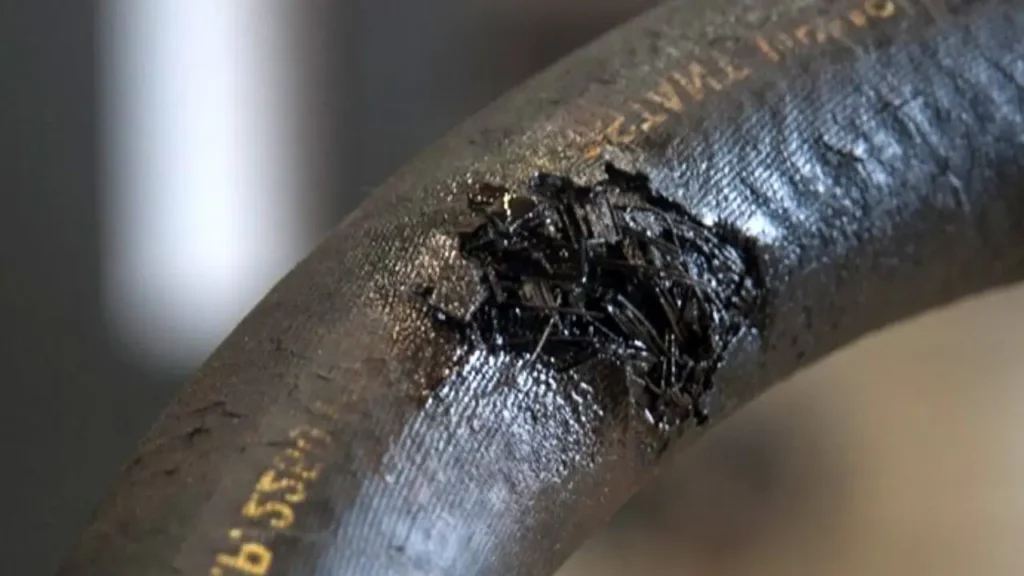
Hydraulic hoses, though robust, are susceptible to various issues that can lead to failures and system downtime. Here are some of the most common problems:
1. Abrasion:
- Cause: Friction against other components or rough surfaces.
- Prevention: Use protective sleeves or guards to shield hoses from abrasion.
2. Kinking:
- Cause: Exceeding the minimum bend radius.
- Prevention: Route hoses carefully, avoiding sharp bends and tight coils.
3. Heat Damage:
- Cause: Exposure to high temperatures.
- Prevention: Shield hoses from heat sources and choose heat-resistant hoses for high-temperature applications.
4. Fluid Incompatibility:
- Cause: Using incompatible hydraulic fluids.
- Prevention: Ensure the hose material is compatible with the fluid to avoid degradation.
5. Improper Installation:
- Cause: Incorrect fitting or over-tightening.
- Prevention: Follow manufacturer‘s guidelines for installation and use the correct tools.
6. Age and Fatigue:
- Cause: Time and repeated flexing.
- Prevention: Implement a regular inspection and replacement schedule.
7. Impact Damage:
- Cause: Physical impact from dropped objects or external forces.
- Prevention: Protect hoses from potential damage during transportation and operation.
By recognizing these common issues and taking preventive measures, you can significantly extend the lifespan of your hydraulic hoses and reduce the risk of costly failures and downtime.
Where Can I Buy Hydraulic Hose
You can purchase hydraulic hoses from various sources, including:
Local Hardware Stores and Supply Shops:
- Stores like Home Depot, Lowe’s, or local hardware stores may carry basic hydraulic hoses and fittings.
- However, for specialized or high-pressure hoses, you may need to visit a more specialized supplier.
Industrial Supply Stores:
- Industrial supply stores, such as Grainger or MSC Industrial Supply, offer a wide range of hydraulic hoses, fittings, and accessories.
- They cater to industrial and commercial needs.
Hydraulic Hose Specialists:
- These specialized suppliers focus on hydraulic components and can provide custom-made hoses and fittings.
- They often have the expertise to help you select the right hose for your specific application.
Online Retailers:
- Online retailers like Amazon or eBay offer a variety of hydraulic hoses and fittings.
- However, it’s important to carefully check product specifications and reviews before purchasing online.
Local Hydraulic Repair Shops:
- These shops can often provide custom-made hoses and fittings.
- They may also offer repair services for damaged hoses.
When purchasing hydraulic hoses, it’s important to consider factors such as pressure rating, temperature range, fluid compatibility, and flexibility. Consulting with a hydraulic hose specialist can help you make the right choice.
You can also purchase premium hydraulic hoses directly from Gushan Rubber. As a leading manufacturer of hydraulic hoses, we offer a wide range of products to meet various industrial needs. You can visit our website or contact our sales team to inquire about our hydraulic hose offerings and purchasing options.
Conclusion
Hydraulic hoses are the lifeblood of countless industries, powering everything from construction equipment to aerospace systems. By understanding their components, types, and applications, you can make informed decisions to ensure the optimal performance and longevity of your hydraulic systems.
Ready to elevate your operations with premium hydraulic hoses?
Contact us today to explore our extensive range of high-quality hydraulic hoses. Our expert team is dedicated to providing tailored solutions to meet your specific needs. From standard to specialized applications, we have the perfect hose for you.
Benefit from our wholesale pricing and exceptional customer service.
Don’t compromise on quality. Choose Gushan Rubber, your trusted partner for hydraulic hose excellence.

